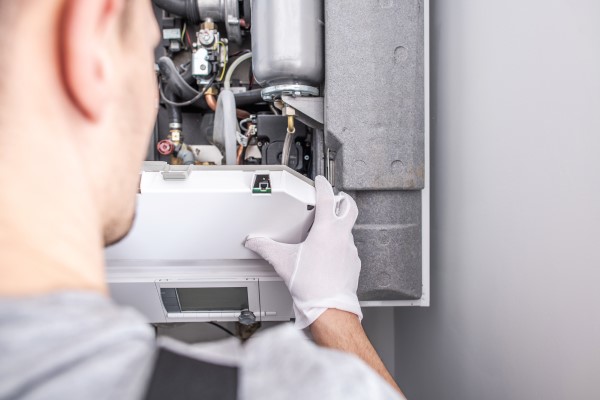The Hidden Costs of an Overworked Furnace: How to Avoid Winter Wear and Tear
Call Us Anytime!
Is Your Furnace Working Too Hard?
As winter approaches, homeowners depend on their furnaces to keep their homes warm and comfortable. However, many people unknowingly overwork their heating systems, pushing them to their limits and creating hidden costs that can strain both your wallet and your furnace.
Running a furnace inefficiently or without proper maintenance doesn’t just increase your energy bills—it can lead to costly furnace repairs, reduced lifespan, and even complete system breakdowns.
This comprehensive guide will explore the hidden costs of an overworked furnace and provide actionable tips to help you reduce strain on your system this fall and winter.




The Hidden Costs of an Overworked Furnace
Higher Energy Bills
An overworked furnace requires more energy to heat your home, especially when it’s running inefficiently. A furnace that hasn’t been properly maintained, or one that’s struggling to keep up with demand due to a clogged filter or leaky ductwork, will consume more fuel or electricity to maintain the desired temperature. This results in higher monthly energy bills.
For instance, if your furnace has dirty filters or poorly calibrated settings, it may run longer cycles or turn on and off more frequently (short cycling). These inefficiencies can increase your heating costs by up to 30%, especially during the colder months when your system is already working harder.
Increased Furnace Repair Costs
Overworking your furnace puts additional strain on its components, such as the blower motor, heat exchanger, and ignition system. This wear and tear can cause components to fail prematurely, leading to expensive repairs. For example:
- A cracked heat exchanger not only impacts efficiency but can also release dangerous carbon monoxide into your home. Replacing this part can cost hundreds or even thousands of dollars.
- A blown blower motor can result in uneven heating and will require immediate attention to avoid further damage to the system.
- Ignition or pilot light issues can prevent your furnace from starting altogether, leaving you without heat during the coldest days of winter.
By neglecting regular maintenance, you may find yourself facing frequent breakdowns and emergency furnace repair costs that could have been avoided.
Shortened Furnace Lifespan
A well-maintained furnace can last 15–20 years, but overworking it without proper care can significantly shorten its lifespan. When your furnace runs inefficiently, the extra strain causes parts to wear out faster, meaning you’ll need to replace the system sooner than expected. Considering the cost of a new furnace installation can range from $3,000 to $7,000 or more, premature replacement is a hidden expense most homeowners want to avoid.
For example, failing to clean or replace filters regularly forces your furnace to work harder to push air through the system. Over time, this extra workload can cause the blower motor or other essential components to burn out, leading to early system failure.
Poor Indoor Air Quality
An overworked furnace that hasn’t been properly maintained can contribute to poor indoor air quality. Dust, debris, and allergens can accumulate in your furnace and ductwork, especially if filters aren’t replaced regularly. As the system circulates air throughout your home, it can also circulate these pollutants, leading to respiratory issues, allergies, and other health concerns.
Additionally, a furnace with a cracked heat exchanger or faulty venting can release harmful gases, such as carbon monoxide, into your living spaces. The long-term health risks associated with poor indoor air quality can create hidden medical costs for your family.
Emergency Breakdowns During Peak Winter Demand
One of the most inconvenient hidden costs of an overworked furnace is the risk of an emergency breakdown during the coldest months. Repairing a furnace in the middle of a winter storm isn’t just inconvenient—it’s often more expensive due to emergency service fees. If replacement parts are needed, supply chain delays during peak demand can leave you without heat for days.
Preventing breakdowns by addressing issues early and maintaining your furnace can save you significant time, stress, and money.
How to Reduce Strain on Your Furnace and Avoid Hidden Costs
Preventing an overworked furnace begins with proper maintenance, early furnace repairs, and energy-efficient practices. Here are actionable steps homeowners can take to reduce strain on their system:
Schedule Annual Maintenance
The best way to ensure your furnace runs efficiently is to schedule an annual maintenance check with a professional HVAC technician. During this service, the technician can:
- Inspect and clean essential components, such as the burners, blower motor, and heat exchanger.
- Test for gas leaks, carbon monoxide, and proper venting.
- Check for worn or damaged parts that may need repair or replacement.
- Calibrate the thermostat for accurate temperature control.
- Ensure optimal system efficiency, reducing the likelihood of breakdowns.
Scheduling maintenance in the fall ensures your furnace is ready to handle the demands of winter.
Replace or Clean Filters Regularly
Clogged filters are one of the leading causes of furnace inefficiency. Dirty filters restrict airflow, forcing the furnace to work harder to circulate air throughout your home. Replacing or cleaning your filter every 1–3 months during the heating season can improve airflow, reduce energy consumption, and prevent strain on the blower motor.
If you have pets or allergies, you may need to replace filters more frequently. Consider using high-efficiency filters to trap more dust and allergens while maintaining good airflow.
Seal Leaks and Insulate Your Home
Air leaks in your home’s ductwork, windows, doors, or walls can cause warm air to escape, forcing your furnace to run longer cycles to maintain a consistent temperature. To reduce strain on your furnace and reduce the need for furnace repairs:
- Seal gaps around windows and doors with weatherstripping or caulk.
- Add insulation to your attic, walls, and basement to prevent heat loss.
- Have a professional inspect and seal any leaks in your ductwork.
Proper insulation and sealing can improve your furnace’s efficiency by up to 20%, significantly reducing your energy bills.
Use a Programmable or Smart Thermostat
A programmable or smart thermostat allows you to optimize your furnace’s heating cycles based on your schedule. By lowering the temperature when you’re asleep or away from home, you can reduce the workload on your furnace without sacrificing comfort. Smart thermostats also provide insights into your energy usage and help identify areas where you can save.
For example, lowering the temperature by 7–10°F for 8 hours a day can save you up to 10% annually on heating costs, according to the U.S. Department of Energy.
Keep Vents and Registers Clear
Blocked or closed vents and registers can disrupt airflow, causing your furnace to work harder to distribute heat. Walk through your home and ensure that all vents are open and free of obstructions like furniture, curtains, or rugs. This simple step improves airflow and reduces strain on your system.
Address Furnace Repairs Promptly
If you notice signs of furnace trouble—such as unusual noises, uneven heating, or increased energy bills—don’t wait to call a professional. Addressing small issues early prevents them from escalating into more serious problems that could lead to expensive repairs or system failure.
Consider Upgrading an Older Furnace
If your furnace is over 15–20 years old, it may be time to consider upgrading to a newer, more energy-efficient model. Modern furnaces with high AFUE ratings (90% or higher) use less fuel to generate the same amount of heat, significantly reducing your energy bills.
While upgrading may seem like a large upfront cost, the long-term savings on energy and furnace repair costs can make it a worthwhile investment.
How Energy-Efficient Upgrades Complement Furnace Longevity
Another effective way to reduce the strain on an overworked furnace is by incorporating energy-efficient upgrades throughout your home. These upgrades not only improve overall comfort but also work in tandem with your furnace to optimize its performance and extend its lifespan. Here’s how energy-efficient enhancements can make a difference:
Energy-Efficient Windows and Doors
Installing double-pane or triple-pane windows and energy-efficient doors can significantly reduce heat loss, ensuring your furnace doesn’t have to compensate for drafts or temperature fluctuations. Many modern windows feature low-emissivity (Low-E) coatings that reflect heat back into the home, further enhancing insulation.
- Impact on Furnace Performance: With less heat escaping, your furnace can run fewer cycles, reducing wear and tear on components like the blower motor and heat exchanger.
- Cost Savings: While the initial investment in energy-efficient windows and doors can be substantial, the reduction in heating and furnace repair costs over time makes it a worthwhile upgrade.
Smart Home Integration
Energy-efficient smart home systems, such as smart thermostats and HVAC zoning systems, can optimize furnace usage by ensuring only occupied rooms are heated to the desired temperature.
- Zoning Systems: By dividing your home into zones, you can direct heat only to the areas where it’s needed, allowing your furnace to work smarter, not harder.
- Thermostat Automation: Smart thermostats adapt to your household routines, ensuring efficient heating schedules and eliminating wasted energy.
Solar Panels and Alternative Energy Sources
For those looking to take energy efficiency to the next level, solar panels or other renewable energy sources can power your furnace and other home systems. While this requires a significant upfront investment, it can drastically lower long-term energy costs and reduce reliance on conventional fuel sources.
High-Efficiency Furnace Upgrades
If your current furnace is over 15–20 years old, upgrading to a high-efficiency model is one of the most impactful steps you can take. Look for furnaces with an AFUE (Annual Fuel Utilization Efficiency) rating of 90% or higher, as these models use less fuel to produce the same amount of heat.
- Advanced Features: Modern furnaces often come with features like variable-speed blowers, modulating burners, and integrated smart controls that improve efficiency and performance.
- Environmental Benefits: High-efficiency furnaces reduce greenhouse gas emissions, contributing to a more sustainable home.
Don’t Spend More on an Overworked Furnace
An overworked furnace can lead to hidden costs that go beyond just higher energy bills. Increased furnace repairs, shortened lifespan, poor indoor air quality, and emergency breakdowns are all risks of running a furnace inefficiently or without proper care. By taking proactive steps to maintain your system, you can reduce strain, lower heating costs, and avoid costly repairs.
Start this fall by scheduling professional maintenance, replacing filters, sealing air leaks, and optimizing your thermostat settings. These simple yet effective practices will ensure your furnace operates efficiently throughout the winter, saving you money and keeping your home warm and comfortable. With proper care, your furnace will provide reliable service for years to come, giving you peace of mind during the coldest months of the year.

